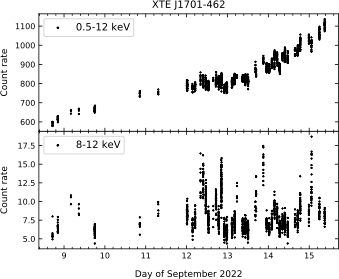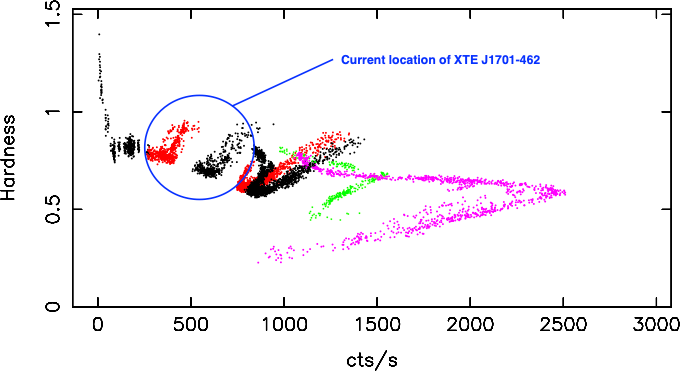NICER / ISS Science Nugget
for September 15, 2022
The Rising of XTE J1701-462
On 6 September, JAXA's MAXI payload detected renewed X-ray activity from XTE J1701-462, a so-called low-mass X-ray binary (LMXB) discovered by NICER's predecessor, the Rossi X-ray Timing Explorer (RXTE). XTE J170 consists of a neutron star with a weak magnetic field which accretes matter from a low-mass companion star. In XTE J1701, the rate of mass flow from the companion star is generally too low for the system to be always active in X-rays; instead, it occasionally goes into a major X-ray outburst during episodes of high-rate accretion. The first time XTE 1701 was observed to do so was in 2006, when it was discovered. It remained in outburst for 19 months. During this outburst, which was extremely well covered , it became the first source observed to transition between all the known subclasses of low-magnetic field neutron star LMXBs, thereby answering longstanding questions about how these subclasses are related to one another. It turned out that all the complex phenomenology observed in these sources is linked by a single parameter: the amount of matter being accreted onto the neutron star.
The detection of renewed activity marks the start of only the second known outburst of XTE J1701. NICER began observing on 8 September and is currently monitoring the rise of the outburst, a phase that was almost completely missed by RXTE during the first outburst. NICER will enable us to better understand the evolution of the emission from the accretion disk, which primarily emits in a band - low energy X-rays - in which NICER is more sensitive than RXTE. The first NICER observations found the source in a state in which it exhibits minor flaring, mostly at high energies. During its first outburst, RXTE showed that XTE J1701 evolves along tracks in a so-called hardness-intensity diagram, in which the "color" of the X-ray energy spectrum is mapped as a function of X-ray brightness. The approximate current location of XTE J1701 in this diagram is indicated. It suggests that XTE J1701 may soon begin to show the more complex behavior that is associated with higher luminosities and mass accretion rates.
Results from NICER's initial observations of XTE J1701 have been reported in Astronomer's Telegram #15605, led by J. Homan of Eureka Scientific.


Figure:
Left: NICER measurements of the brightness of low-mass X-ray binary XTE J1701-462 during the rising phase of its current outburst. The top panel shows the rate of detected X-ray photons across nearly the full NICER energy band, 0.5 to 12 keV, while the bottom panel restricts the energy range to the high end of that band, 8 to 12 keV. Modest flaring is evident in the high-energy band.
Right: Hardness-intensity diagram of XTE J1701-462, derived from Rossi X-ray Timing Explorer observations starting in 2006. Colored points represent the evolving relationship between X-ray "color" (vertical axis) and brightness (horizontal axis) across different accretion states spanning the 19-month outburst.
<< Previous
Main Index
Next >>